Unit-5
Geotechnical properties of reinforced soil
INTRODUCTION
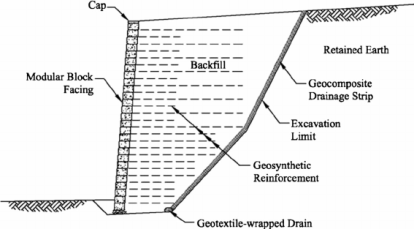
Fig no 1 Schematic diagram of a reinforced earth wall
REINFORCED EARTH WALL
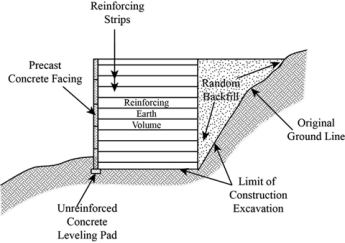
Fig no 2 Reinforced earth wall
MECHANICALLY STABILISED EARTH WALL
FACTOR AFFECTING PERFORMANCE OF REINFORCED SOIL
Reinforced soil could be stuff comprising of granular soil and reinforcement, therefore its behavior on the property of every material and also the bonding action between them to own additional interlocking friction
Following factors can affect the performance of bolstered soil
Advantages of reinforced Soil Structures
Disadvantages
The following general disadvantage is also associated with all soil bolstered structures.
Requirements for bolstered soil slopes are usually less restrictive. the appropriate criterion is needed to deal with corrosion of steel reinforcing elements, deterioration of sure styles of exposed facing parts like geosynthetics by immoderate violet rays, and potential degradation of compound reinforcement within the ground
Since design and construction apply of all bolstered systems are still evolving, specifications and catching practices haven't been standardized
HISTORY OF SOIL REINFORCEMENT
Key takeaways
INTRODUCTION
GENERAL PRINCIPLES
REINFORCING PARTS AND THEIR USES
The reinforcing parts might consist of:
STRIP REINFORCING ELEMENTS
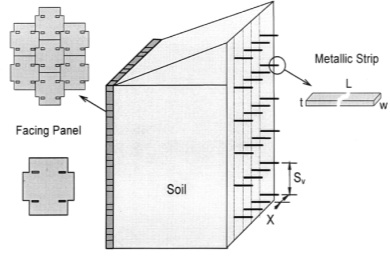
Fig no 3 Strip elements
GEOTEXTILE SHEETS
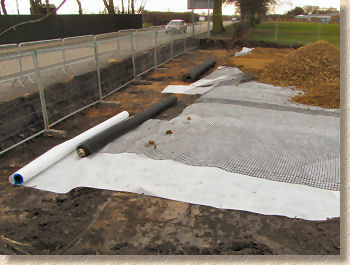
Fig no 4 Geotextile sheet
GEOGRIDS AND METALLIC GRIDS
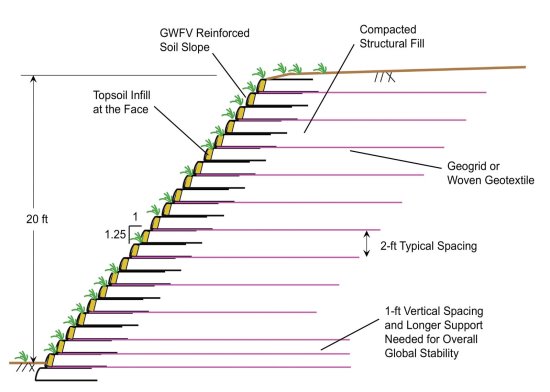
Fig no 5 Geogrid
Key takeaways
Use of soil reinforcement in different reinforcing parts
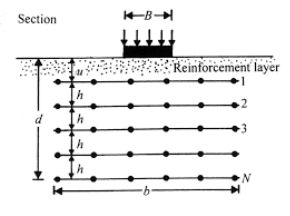
Fig no 6 Shallow foundation
Designing for Condition
(a): Pore water Pressures Generated among the bolstered Fill
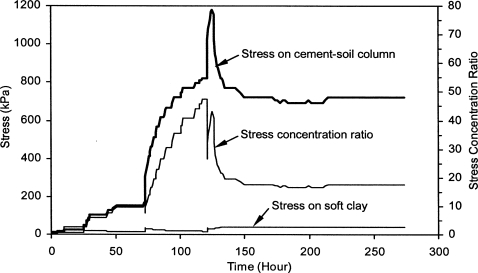
Fig no 7 Pores water pressure
2. Effective stress analysis accounting for full lateral voidance by the reinforcement. Full voidance of the bolstered fill is assumed for the long conditions. This analysis provides a practical analysis of the long stability of the structure, as a result of the dissipation of pore water pressures generated throughout construction ought to have occurred through the semipermeable inclusions. This analysis determines the minimum reinforcement necessities which will offer adequate stability below long conditions following the dissipation of pore water pressures generated throughout the construction of the structure. it'sstressed that the transmission of the reinforcements ought to be designated so the generation of pore water pressures is prevented at the soil-reinforcement interface. Typically, the soil shear strength ought to be supported by consolidated undrained (CIU) triaxial tests performed on saturated samples with pore pressure measurements or consolidated drained (CD) triaxial tests. The long-run style issue of safety usually needed for reinforcement of granular fills (e.g. 1.3 to 1.5) ought to be employed in this analysis.
Designing for Condition
(b): Wetting Front Advancing into the bolstered Fill
As loss of strength could occur attributable to a wetting front advancing into the bolstered fill geosynthetic transmission necessities ought to be established to avoid the advancement of wetting front for expected conditions. A two-phase analysis is additionally planned during this case. These analyses, summarized in Table one, area unit as follows:
1) Total stress analysis ignoring the result of lateral voidance in preventing the advancement of a wetting front. This analysis is performed exploitation shear strength properties of the bolstered soil mass outlined exploitation saturated specimens. The results of this analysis offer an estimate of the steadiness of the structure below an advancing wetting front. This analysis is conservative as a result of the backfill is assumed saturated, which mustn't occur in actual follow as a result of the wetting front is intercepted by the semipermeable reinforcements. Consequently, an element of safety of one.1 is suggested during this case. Water pressure which will develop as water fills surface cracks (induced by desiccation, freeze/thaw, or slope movements) ought to be accounted for exploitation boundary water pressures within the analysis.
2) Total stress analysis accounting for the result of lateral voidance in preventing the advancement of a wetting front. The whole shear strength is outlined from unsaturated specimens ready at the best wetness anticipated within the fill. Note that the whole shear strength outlined from unsaturated specimens ought to be more than the effective shear strength of the fill. Complete stress analysis is taken into account during this case, rather than an efficient stress analysis, to account for the helpful result of the negative pore-water pressures within the unsaturated bolstered fill. The shear strength of the bolstered fill higher than the highest bolstered layer (which could become saturated) ought to be obtained from saturated specimens. This analysis provides a practical analysis of the steadiness of the structure as a result of it accounts for the lateral voidance of the geosynthetic reinforcements.
Designing for Condition
(c): Seepage Configuration Established among the bolstered Fill
1. Total stress analysis ignoring reinforcement lateral voidance. This analysis considers ooze forces outlined from a flow configuration that might develop in an unreinforced slope. The results of this analysis offer a conservative estimate of the steadiness of the structure throughout a seasonal speedy configuration of ooze flow among the fill. The ideology of this analysis is as a result of (1) the backfill is assumed as absolutely saturated, which does not occur in actual follow, and (2) the ooze configuration doesn't account for the lateral voidance provided by the reinforcements. Therefore, a comparatively low issue of safety of one.1 is suggested during this case (note that ooze forces area unit thought of within the analysis).
2. Effective stress analysis accounting for full reinforcement lateral voidance. Full voidance of the bolstered fill is assumed for the everyday condition of the structure. This analysis provides a practical analysis of the long stability of the structure as a result of it accounts for the lateral voidance of the geosynthetic reinforcements. No ooze forces area unit thought of to develop among the bolstered fill if the reinforcements offer adequate internal voidance.
Key takeaways
Design consideration depending on various conditions
IDEALIZED SOIL RESPONSE MODELS FOR THE ANALYSIS OF SOIL-FOUNDATION INTERACTION
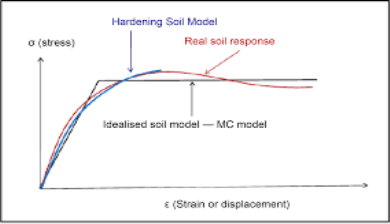
Fig no 8 Idealized soil
Soil-structure interaction interdisciplinary field that involves structural and geotechnical engineering. Within the standard non-interaction analysis of the building frame,the structural designer assumed that columns are resting on unyielding support.
1. Introduction
2. Linear soil-structure interaction beneath static loading
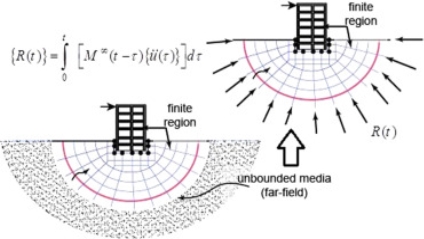
Fig no 9 Linear soil structure
3. Nonlinear soil-structure interaction beneath static loading
![PDF] Non-Linear Seismic Soil-Structure Interaction Analysis Based on the Substructure Method in the Time Domain | Semantic Scholar](https://glossaread-contain.s3.ap-south-1.amazonaws.com/epub/1642793420_496737.png)
Fig no 10 Non liner soil structure
4. Elastic-plastic soil structure interaction below static loading
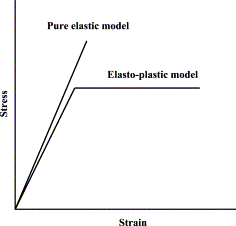
Fig no 11 Elastic-plastic soil structure
5. viscosity-elastic/plastic soil-structure
6. Soil-structure interaction below dynamic loading
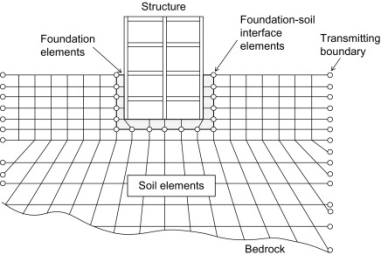
Fig no 12 Soil structure interaction below dynamic loading
Key takeaways
They include
References:
1. C venkataramaiah: geotechnical engineering
2. Taylor D W: Fundamental of soil mechanics,Mumbai
3. Arora KR: soil mechanics and foundation engg, Delhi